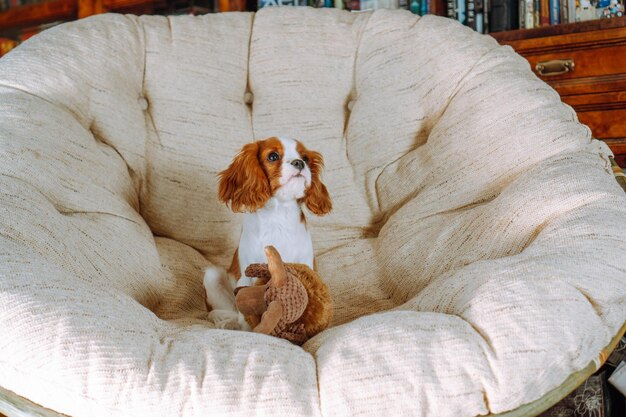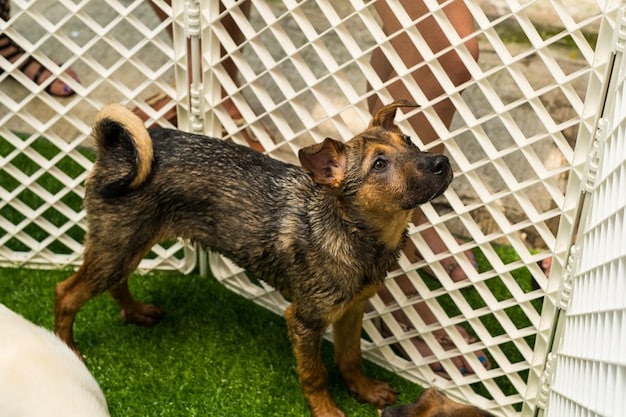Crate Training Challenges: How to Solve Problems in 2025

Crate training challenges in 2025 often involve anxiety, resistance, and improper introduction, but understanding these obstacles allows pet owners to implement effective solutions like positive reinforcement, gradual acclimatization, and consistent routines, fostering a safe and comfortable space for their dogs.
Navigating the world of crate training can feel like a maze, but understanding the common hurdles is the first step to success; let’s explore the crate training challenges: overcome common crate training problems in 2025.
Understanding the Basics of Crate Training
Crate training is a valuable tool for dog owners, providing a safe and secure space for your furry friend. It can aid in housetraining, prevent destructive behaviors, and offer a comforting den for your dog. However, like any training method, it comes with its own set of challenges.
What is Crate Training and Why Does it Matter?
Crate training involves teaching your dog to associate the crate with positive experiences, making it a comfortable and safe haven. This process not only benefits your dog but also simplifies various aspects of pet ownership.
- Housetraining Aid: Crates help dogs learn to control their bladder and bowels by instinctively avoiding soiling their enclosed space.
- Security and Comfort: A crate can become a dog’s personal den, a place where they feel safe and secure, especially during times of stress like thunderstorms or fireworks.
- Prevention of Destructive Behavior: When you’re not able to supervise your dog, a crate prevents them from engaging in destructive behaviors like chewing furniture or scratching doors.
Proper crate training establishes the crate as a positive space, reducing anxiety and promoting a sense of security. This is crucial for your dog’s overall well-being and behavioral health.
Common Resistance and How to Handle It
One of the most frequent obstacles in crate training is a dog’s resistance to entering the crate. This resistance can manifest in various ways, from reluctance to enter to outright refusal and even signs of distress.

Why Dogs Resist the Crate Initially
Understanding the reasons behind a dog’s reluctance can help in addressing the problem effectively. Common causes include past negative experiences, association of the crate with punishment or isolation, and natural anxiety towards confinement.
To ease your dog into crate training, consider these steps:
- Positive Association: Make the crate a positive place by associating it with treats, toys, and praise.
- Gradual Introduction: Start by leaving the crate door open and allowing your dog to explore it at their own pace. Don’t force them inside.
- Comfortable Bedding: Place soft and comfortable bedding inside the crate to make it more inviting.
By creating positive associations and a comfortable environment, you can alleviate your dog’s resistance and encourage them to see the crate as a safe and pleasant space.
Separation Anxiety and Crating
Separation anxiety can significantly complicate your crate training efforts. Dogs experiencing separation anxiety may exhibit extreme distress when left alone in a crate, leading to destructive behavior and self-harm.
Addressing Separation Anxiety
Recognizing the signs of separation anxiety is crucial for effective management. Common symptoms include excessive barking, howling, destructive chewing, and attempts to escape the crate.
Effective strategies for managing separation anxiety during crate training include:
- Desensitization: Gradually increasing the amount of time your dog spends in the crate while you’re nearby can help them become more comfortable.
- Counter-Conditioning: Pairing crate time with high-value rewards, like a favorite chew toy or a special treat, can help change your dog’s emotional response to the crate.
- Professional Help: Consulting with a certified dog trainer or behaviorist can provide tailored strategies for addressing your dog’s specific needs and anxiety levels.
Addressing separation anxiety requires patience and consistency. By implementing these strategies, you can help your dog feel more secure and reduce their distress when crated.
Dealing with Barking and Whining
Excessive barking and whining are common challenges during crate training, often stemming from anxiety, boredom, or a desire for attention. Understanding the underlying cause of these behaviors is crucial for effective intervention.

Strategies for Quieting a Distressed Dog
When your dog starts barking or whining in their crate, it’s essential to respond in a way that doesn’t reinforce the behavior. Here are some effective strategies:
Ensure needs are met:
- Ignore the Behavior: As long as you’re sure your dog has been fed, has relieved themselves and has access to water, avoid giving attention to the barking or whining, as any response can inadvertently reinforce the behavior.
- Provide Stimulation: Offer a stimulating chew toy or puzzle toy to keep your dog occupied and mentally engaged. This can help reduce boredom and anxiety.
If the barking or whining continues despite these efforts, consider consulting with a dog trainer or behaviorist. They can help identify any underlying issues and develop a tailored training plan.
Crate Size and Comfort
The size and comfort of the crate play a crucial role in your dog’s acceptance of and comfort within it. An inappropriately sized or uncomfortable crate can exacerbate anxiety and hinder the training process.
Ensuring the Right Fit
A properly sized crate should be large enough for your dog to stand up, turn around, and lie down comfortably, but not so large that they can eliminate in one area and sleep in another. Too much space can diminish the crate’s effectiveness as a housetraining tool.
Consider these factors when choosing a crate:
- Measure Your Dog: Measure your dog’s height and length to determine the appropriate crate dimensions.
- Opt for Adjustability: If you have a puppy, consider purchasing a crate with a divider panel. This allows you to adjust the size of the crate as your puppy grows, preventing them from using one end as a toilet area.
In addition to size, consider the comfort of the crate: include soft bedding, familiar toys, and items that carry your scent, such as an old t-shirt. These elements can create a cozier and more inviting space for your dog.
The Importance of Consistency and Patience
Consistency and patience are key virtues in crate training. Rushing the process or using inconsistent methods can lead to confusion and increased resistance from your dog.
Establishing a Routine
Establishing a consistent crate training routine helps your dog understand what is expected of them. This can include regular crate time for naps, meals, and when you’re away from home.
Here is how to be consistent:
- Regular Feeding: Feed your dog their meals in the crate to create a positive association.
- Scheduled Crate Time: Incorporate scheduled crate time into your daily routine, even when you’re home. This helps your dog become accustomed to spending time in the crate regardless of your presence.
Consistency also extends to your behavior: always use positive reinforcement, avoid punishing your dog for accidents in the crate, and remain calm and patient throughout the process. Remember, crate training is a gradual process that requires time and dedication.
Overcoming Setbacks and Plateaus
Even with the best efforts, you may encounter setbacks or plateaus in your crate training progress. These challenges can be frustrating, but it’s important to remain flexible and adapt your approach as needed.
To handle these challenges:
- Re-evaluate Your Approach: If your dog is suddenly resistant to entering the crate, take a step back and re-evaluate your training methods. Are you moving too quickly? Is the crate still a positive place for them?
- Consult with a Professional: Don’t hesitate to seek guidance from a certified dog trainer or behaviorist. They can provide personalized advice and help you identify any underlying issues that are hindering your progress.
Remember that every dog is unique, and what works for one may not work for another. Be willing to experiment with different strategies and seek professional guidance when needed. With persistence and patience, you can overcome setbacks and achieve your crate training goals.
| Key Point | Brief Description |
|---|---|
| 🏠 Positive Association | Make the crate a pleasant space with treats and toys. |
| ⏰ Gradual Introduction | Introduce the crate slowly, never forcing your dog inside. |
| 🐾 Consistent Routine | Establish a regular schedule for crate time and feeding. |
| ❤️ Addressing Anxiety | Use desensitization and counter-conditioning for anxious dogs. |
Frequently Asked Questions
▼
Sudden refusal might indicate a negative experience associated with the crate, such as a loud noise or a period of prolonged isolation. Reintroduce the crate gradually with positive reinforcement.
▼
Puppies can generally hold their bladder for their age in months plus one, in hours. However, never leave a puppy in a crate for longer than 4 hours during the day to avoid accidents.
▼
Excessive barking could stem from anxiety or boredom. Ignore the barking if needs are met, provide stimulating toys, and consider consulting with a professional trainer if the behavior persists.
▼
When done correctly, crate training is not cruel. It provides a safe den for your dog, reducing anxiety and preventing destructive behaviors. Make sure to create a positive association with the crate.
▼
Add soft bedding, familiar toys, and items with your scent to the crate. Ensure the crate is the right size and in a comfortable location, away from drafts and direct sunlight.
Conclusion
Overcoming crate training challenges in 2025 involves understanding your dog’s individual needs, using positive reinforcement techniques, and staying consistent with your training approach. With patience and dedication, you can transform the crate into a safe and comforting space for your furry friend.





